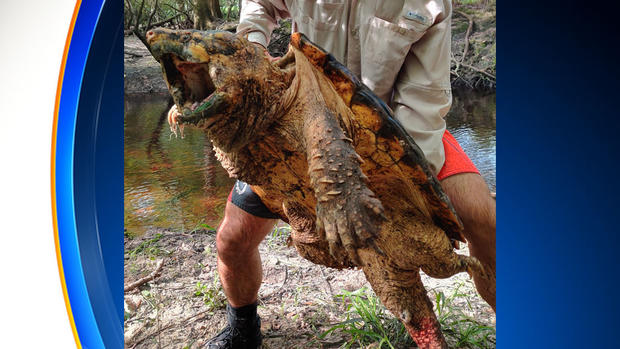Monster-Sized Suwannee Alligator Snapping Turtles Trapped In North Florida Were Not Harmed
GAINESVILLE (CBSMiami) – Three monster-sized Suwannee alligator snapping turtles discovered recently in north Florida were not harmed in any way, according to the Florida Fish and Wildlife Conservation Commission.
After CBSMiami.com posted a story earlier this week about the new species of turtle found in the Suwannee River near Gainesville, a lot of people wanted to know what happened to them after they were trapped.
Were they hurt? Were they released?
Well the answer is they were not hurt. After the FWC researchers collected their data and took some pictures, they were all released back into the New River where they were originally trapped.
And no, not the New River in Fort Lauderdale.
This New River is a 31-mile-long tributary of the Santa Fe River, north of Gainesville.
A total of three turtles were trapped; a 100-pound male, a 64-pound male and a 46-pound female.
The FWC researchers believe the turtles are between 40-80 years old.
Why are these turtles considered a new species?
According to FWC on its Facebook post:
"Formerly, the alligator snapping turtle (Macrochelys temminckii) was considered a single, wide-ranging species that extended from the Suwannee River drainage west into Texas. Based upon genetic differentiation and differences in skull and carapace morphology, Thomas et al. (2014) described two new species of alligator snapping turtle, the Suwannee (M. suwanniensis) and Apalachicola (M. apalachicolae). The Apalachicola species occurs from the Ochlockonee drainage west to the Choctawhatchee drainage in Florida, Georgia, and Alabama. The validity of the Apalachicola species has been disputed by other researchers, but everyone agrees that the Suwannee species is distinct. The Suwannee alligator snapping turtle has been isolated for at least 5.5 million years, during which time it has undergone sufficient evolutionary changes to differentiate it from other alligator snapping turtles. Alligator snapping turtle populations apparently do not occur in the seven small streams between the Suwannee and Ochlockonee rivers in Florida."
FWC added it is collaborating with researchers in Florida and Georgia on the new species, "to document the distribution and relative abundance of this state threatened species."





